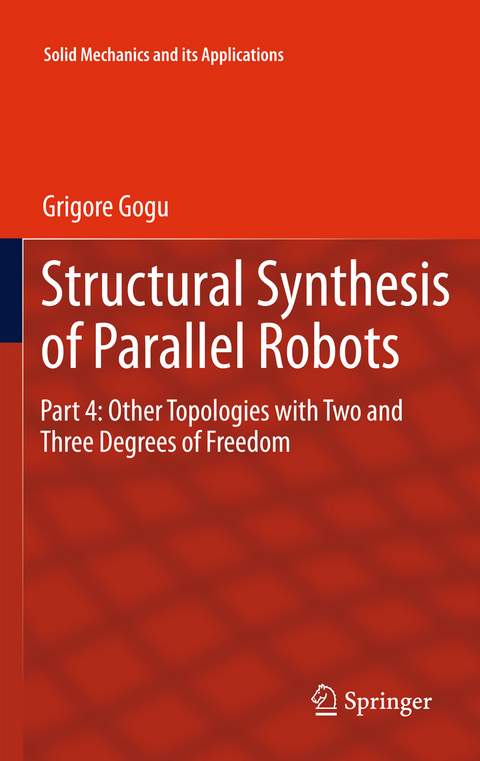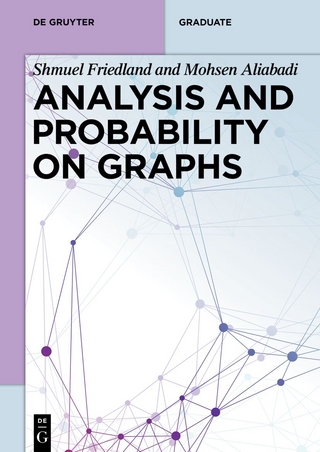
Structural Synthesis of Parallel Robots
Springer (Verlag)
978-94-007-3774-7 (ISBN)
The originality of this work resides in the fact that it combines the new formulae for mobility connectivity, redundancy and overconstraints, and the evolutionary morphology in a unified approach of structural synthesis giving interesting innovative solutions for parallel robotic manipulators.
This is the first book of robotics presenting various solutions of coupled, decoupled, uncoupled, fully-isotropic and maximally regular parallel robotic manipulators with two and three degrees of freedom systematically generated by using the structural synthesis approach proposed in Part 1. Non-redundant/redundant, overconstrained/isostatic solutions with simple/complex limbs actuated by linear/rotary actuators with/without idle mobilities are proposed. Many solutions are presented here for the first time in the literature.
The author had to make a difficult and challenging choice between protecting these solutions through patents, and releasing them directly into the public domain. The second option was adopted by publishing them in various recent scientific publications and mainly in this book. In this way, the author hopes tocontribute to a rapid and widespread implementation of these solutions in future industrial products.
Preface.- Acknowledgements.- List of abbreviations and notations.- 1 Introduction.- 1.1 Terminology.- 1.1 Links, joints and kinematic chains.- 1.2 Serial, parallel and hybrid robots.- 1.2 Methodology of structural synthesis.- 1.2.1 New formulae for mobility, connectivity, redundancy and overconstraint of parallel robots.- 1.2.2 Evolutionary morphology approach.- 1.2.3 Types of parallel robots with respect to motion coupling.- 2 Parallel mechanisms with cylindrical motion of the moving platform.- 2.1 T1R1-type parallel mechanisms with coupled cylindrical motion.- 2.1.1 Overconstrained solutions.- 2.1.2 Non overconstrained solutions.- 2.2 T1R1-type parallel mechanisms with decoupled cylindrical motion.- 2.2.1 Overconstrained solutions.- 2.2.2 Non overconstrained solutions.- 2.3 T1R1-type parallel mechanisms with uncoupled cylindrical motion.- 2.3.1 Overconstrained solutions.- 2.3.2 Non overconstrained solutions.- 2.4 Maximally regular parallel mechanisms with cylindrical motion.- 2.4.1 Overconstrainedsolutions.- 2.4.2 Non overconstrained solutions.- 3 Other T1R1-type parallel mechanisms.- 3.1 T1R1-type parallel mechanisms with coupled motions.- 3.1.1 Overconstrained solutions.- 3.1.2 Non overconstrained solutions.- 3.2 T1R1-type parallel mechanisms with decoupled motions.- 3.2.1 Overconstrained solutions.- 3.2.2 Non overconstrained solutions.- 3.3 T1R1-type parallel mechanisms with uncoupled motions.- 3.3.1 Overconstrained solutions.- 3.3.2 Non overconstrained solutions.- 3.4 Maximally regular T1R1-type parallel mechanisms.- 3.4.1 Overconstrained solutions.- 3.4.2 Non overconstrained solutions.- 4 Parallel wrists with two degrees of freedom.- 4.1 R2-type parallel wrists with coupled motions.- 4.1.1 Overconstrained solutions.- 4.1.2 Non overconstrained solutions.- 4.2 R2-type parallel wrists with decoupled motions.- 4.2.1 Overconstrained solutions.- 4.2.2 Non overconstrained solutions.- 4.3 R2-type parallel wrists with uncoupled motions.- 4.3.1 Overconstrained solutions.- 4.3.2 Nonoverconstrained solutions.- 4.4 Maximally regular R2-type parallel wrists.- 4.4.1 Overconstrained solutions.- 4.4.2 Non overconstrained solutions.- 5 T2R1-type overconstrained spatial parallel manipulators.- 5.1 Overconstrained solutions with coupled motions.- 5.1.1 Fully-parallel solutions.- 5.1.2 Non fully-parallel solutions.- 5.2 Overconstrained solutions with decoupled motions.- 5.2.1 Fully-parallel solutions.- 5.2.2 Non fully-parallel solutions.- 5.3 Overconstrained solutions with uncoupled motions.- 5.3.1 Fully-parallel solutions.- 5.3.2 Non fully-parallel solutions.- 5.4 Overconstrained maximally regular solutions.- 5.4.1 Fully-parallel solutions.- 5.4.2 Non fully-parallel solutions.- 6 Non overconstrained T2R1-type spatial parallel manipulators.- 6.1 Non overconstrained solutions with coupled motions.- 6.1.1 Fully-parallel solutions.- 6.1.2 Non fully-parallel solutions.- 6.2 Non overconstrained solutions with decoupled motions.- 6.2.1 Fully-parallel solutions.- 6.2.2 Non fully-parallel solutions.- 6.3 Non overconstrained solutions with uncoupled motions.- 6.3.1 Fully-parallel solutions.- 6.3.2 Non fully-parallel solutions.- 6.4 Non overconstrained maximally regular solutions.- 6.4.1 Fully-parallel solutions.- 6.4.2 Non fully-parallel solutions.- 7 T1R2-type spatial parallel manipulators.- 7.1 T1R2-type spatial parallel manipulators with coupled motions.- 7.1.1 Overconstrained solutions.- 7.1.2 Non overconstrained solutions.- 7.2 T1R2-type spatial parallel manipulators with decoupled motions.- 7.2.1 Overconstrained solutions.- 7.2.2 Non overconstrained solutions.- 7.3 T1R2-type spatial parallel manipulators with uncoupled motions.- 7.3.1 Overconstrained solutions.- 7.3.2 Non overconstrained solutions.- 7.4 Maximally regular T1R2-type spatial parallel manipulators.- 7.4.1 Overconstrained solutions.- 7.4.2 Non overconstrained solutions.- 8 Parallel wrists with three degrees of freedom.- 8.1 Parallel wrists with coupled motions.- 8.1.1 Overconstrained solutions.- 8.1.2 Non overconstrained solutions.- 8.2 Parallel wrists with decoupled motions.- 8.2.1 Overconstrained solutions.- 8.2.2 Non overconstrained solutions.- 8.3 Parallel wrists with uncoupled motions.- 8.3.1 Overconstrained solutions.- 8.3.2 Non overconstrained solutions.- 8.4 Maximally regular parallel wrists.- 8.4.1 Overconstrained solutions.- 8.4.2 Non overconstrained solutions.- 9 Parallel mechanisms with dependent motions of the moving platform.- 9.1 Solutions with two degrees of freedom.- 9.1.1 Overconstrained solutions.- 9.1.2 Non overconstrained solutions.- 9.2 Solutions with three degrees of freedom.- 9.1.1 Overconstrained solutions.- 9.1.2 Non overconstrained solutions.- References.- Index.
| Reihe/Serie | Solid Mechanics and Its Applications ; 183 |
|---|---|
| Zusatzinfo | XX, 628 p. |
| Verlagsort | Dordrecht |
| Sprache | englisch |
| Maße | 155 x 235 mm |
| Themenwelt | Mathematik / Informatik ► Mathematik ► Wahrscheinlichkeit / Kombinatorik |
| Naturwissenschaften ► Physik / Astronomie ► Mechanik | |
| Technik ► Elektrotechnik / Energietechnik | |
| Technik ► Maschinenbau | |
| ISBN-10 | 94-007-3774-2 / 9400737742 |
| ISBN-13 | 978-94-007-3774-7 / 9789400737747 |
| Zustand | Neuware |
| Informationen gemäß Produktsicherheitsverordnung (GPSR) | |
| Haben Sie eine Frage zum Produkt? |
aus dem Bereich


